Dominaria United States of Design, Part 1
For today and the next two weeks, I'm going to tell a bunch of card-by-card design stories from Dominaria United. In today's column, I'm just going to tell two stories, but they involved characters that each had a whole storyline that never happened. I'll walk you through the story that could have been and then introduce you to the character's card in Dominaria United.
Ertai Resurrected
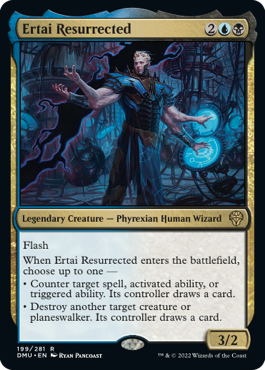
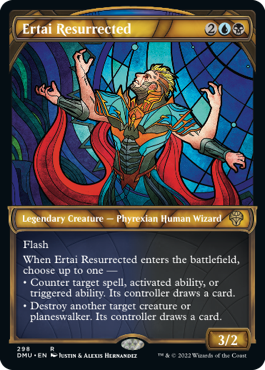
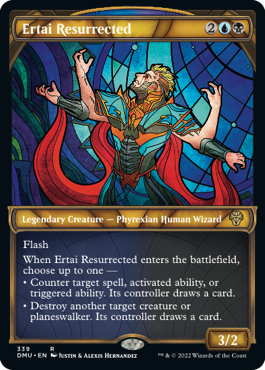
When Michael Ryan and I first created the Weatherlight Saga, we planned it as a three-year arc (with the idea that there would be more stories to tell with the characters, but this would be the first one). Here's the abbreviated version of what we pitched.
Year One
Captain Sisay is kidnapped by Volrath and taken to the plane of Rath. The Weatherlight crew seeks out the help of Gerrard (and in turn Mirri, Ertai, Crovax, and Starke) to help rescue Sisay. The crew makes their way to Volrath's Stronghold where they rescue Sisay, plus Takara (Starke's daughter), and Karn and Tahngarth (who had been captured). Ertai travels to a portal to open it and make sure the Weatherlight has a way to leave Rath. Things don't quite go according to plan, and the only way to make it through the portal before it closes is to use a device called the Windshaper (which allows the Weatherlight to travel very fast), but in doing so, traps Ertai on Rath. (The reason the Weatherlight needs to use a portal is its planeshifting engine is damaged by another ship, the Predator, when they first arrive in Rath and lose their plane-hopping ability.)
This is basically what happened in the actual card sets (Tempest block), except in our version, Crovax doesn't go bad, kill Mirri, and leave. Mirri being alive, but injured, is an important part of year two. Michael and I stopped working on the story after Stronghold, so Exodus is where the story starts to diverge.
Year Two
The Weatherlight crashes on the other side of the portal in a mercantile city world named Mercadia. The leader of Mercadia becomes fascinated with the Weatherlight and ends up forcing Gerrard to sell it to him in exchange for the medicine that will save Mirri's life. Meanwhile, Starke is killed, and there's a huge murder mystery built into the set for the audience to figure out. (It was Volrath who was on the ship disguised as Tahngarth.) Also, Hanna has been digging deeper into the information they learned in the Stronghold about a Phyrexian invasion, and they piece together that the Phyrexians are going to soon invade Dominaria. They have to get back to warn them. With the help of some allies from Mercadia, Gerrard is able to make use of a little-known rider in the city's bylaws that lets him challenge the leader of Mercadia, and his allies, to an elaborate contest. They manage to win back the ship and learn of a portal that can get them back to Dominaria. Year two ends with the Weatherlight flying through the portal to Dominaria to warn them of the incoming invasion. When they arrive, they realize that the portal not only travelled through space but also through time. It's 50 years later, and the Phyrexians have already attacked and taken over Dominaria.
The only overlap between our version of the story and the one that got made was the world of Mercadia, which was radically changed from how Michael and I envisioned it. Volrath did kill Starke, but disguised as his daughter Takara and not Tahngarth.
Year Three
The Weatherlight crew has to survive in a Phyrexianized Dominaria, hoping to find some way to undo what has happened. They are tracked down by an old wizard who is the leader of the resistance. That old wizard turns out to be none other than Ertai. He is excited to see the Weatherlight crew because the key to Dominaria's salvation rests on an artifact lost to time—something known as the Hourglass Pendant. The last person known to have it was Gerrard. Gerrard had left it with a friend, so the crew has to track it down.
Meanwhile, Volrath, who's still aboard as Tahngarth, sees an opportunity to get back in with the Phyrexians and informs them of the Weatherlight's return. The Weatherlight crew has many adventures finding the pendant, dealing with the Phyrexians, and even fighting Volrath in dragon form, but in the end, they save the day by banishing the Phyrexians from Dominaria and defeating Volrath.
The players saw almost nothing of the plot of this third year. The Hourglass Pendant was referenced in the early part of the story, but it was a thread that never got picked up again. There was one reference to the old Ertai that did make it to print, but the reference never blatantly says its Ertai. In the book Rath and Storm, the bookending story (the book is a collection of short stories about Tempest block) is about a young boy and an old wizard known only as "the master." This part was written by Michael Ryan and was meant as a tease of the Ertai story to come.
Which brings us to the making of Dominaria United. Ethan Fleischer was a fan of all the old lore and had deduced that "the master" was Ertai. So, when Ertai died in the story, Ethan was surprised. How could Ertai die when he's destined to become the old man in Rath and Storm? Ethan decided he was going to right this wrong and talked to the Creative team about resurrecting Ertai in Dominaria United. They were on board. Ethan just had to design an Ertai card.
To refresh everyone's memory, here are the two legendary Ertai cards that existed:
Ertai, Wizard Adept was the version of the character that Michael and I made. He's a powerful wizard, but he's young and cocky. I'd been wanting to do a creature with an activated counterspell for ages, and Ertai felt like the perfect place to finally make it. Him being legendary would keep you from having more than one of him on the battlefield (barring copying shenanigans), and we made him a 1/1 so he'd be easy to kill.
Once Michael and I left the story, Ertai took a path we hadn't planned for him. He got captured and corrupted, ultimately becoming a servant of Crovax. Ertai, the Corrupted was Ertai's second card, and it showed his downfall. Instead of being mono-blue, he was blue and black to represent the corruption, and while he could still counter spells, it now required sacrificing a creature or enchantment.
Here's our first version of Ertai:
Ertai, Resurrected Evincar (version#1)
3UB
Legendary Creature — Phyrexian Wizard
3/4
1UB, T: Counter target spell. You lose life equal to its converted mana cost.
3, Sacrifice a nonland permanent: You gain 4 life.
We didn't stray too far from his previous card. Ertai was still blue and black, still activated to counter spells, and still sacrificed permanents for a resource. As we often like doing, we connected the two abilities by having the second one gain the resource that you have to spend to use the first one.
Ertai, Resurrected Evincar (version #2)
3UU
Legendary Creature — Phyrexian Wizard
3/4
1UU, T, Discard a card: Counter target spell.
3, Sacrifice a nonland permanent: Draw a card.
Ertai then moved to mono-blue. The life gain no longer made sense, so the resource turned from life to cards. Now, you have to discard a card to counter a spell, but sacrificing a nonland permanent can get you the card back.
Ertai, Resurrected Evincar (version #3)
1UU
Legendary Creature — Phyrexian Wizard
2/1
Kicker {o2} (You may pay an additional {o2} as you cast this spell.)
Flash
When CARDNAME enters the battlefield, return target spell to its owner's hand. If CARDNAME was kicked, counter that spell instead.
The next version moved further away from matching old Ertai designs (Play Design wasn't crazy about repeatable counterspells) and started incorporating a set mechanic, kicker, in its place. Instead of activating to counter a spell, Ertai now does it as an "enters the battlefield" (ETB) effect. The kicker lets you choose whether you're temporarily stopping the spell or permanently stopping it.
Ertai, Resurrected Evincar (version #4)
2UU
Legendary Creature — Phyrexian Wizard
2/2
Flash
When CARDNAME enters the battlefield, counter target spell an opponent controls.
Grandeur — UU, Discard another card named CARDNAME: Counter target spell.
The next incarnation makes use a of a different mechanic in the set (well, at the time), grandeur. This version of Ertai straight up counters a spell as an ETB effect and then allows you to turn your other Ertais into, quite literally, counterspells.
Ertai, Resurrected Evincar (version #5)
2WU
Legendary Creature — Phyrexian Wizard
2/2
Flash
When CARDNAME enters the battlefield, counter target spell an opponent controls. You gain life equal to the number of creatures you control.
Grandeur — WU, Discard another card named CARDNAME: Counter target spell an opponent controls. You gain life equal to the number of creatures you control.
For some reason—and I believe this was during set design—they decided to try Ertai as a white-blue card. He kept his ETB countering effect but was combined with life gain, I assume to capture the white part of the card. The grandeur ability again allows you to discard future copies of Ertai to generate the same effect as the ETB effect.
Ertai, Resurrected Evincar (version #6)
1WUU
Legendary Creature — Phyrexian Wizard
2/2
Flash
When CARDNAME enters the battlefield, counter target spell an opponent controls. You gain life equal to the number of creatures you control.
Then grandeur left the file, so the card lost grandeur. It also changed its mana cost to require you spend more blue mana to cast it.
Ertai, Resurrected Evincar (version #7)
1UUB
Legendary Creature — Phyrexian Wizard
3/2
Flash
When CARDNAME enters the battlefield, counter target spell an opponent controls. It's controller loses 3 life.
My best guess is that was the point where someone from the Creative team said, "What are you doing? Ertai's blue-black not white-blue." The card was change to blue-black and tweaked slightly to change the extra effect from feeling white to feeling black.
Ertai, Resurrected Evincar (version #8)
UUB
Legendary Creature — Phyrexian Wizard
2/3
Flash
CARDNAME enters the battlefield with a +1/+1 counter for each spell that's been cast this turn. When CARDNAME enters the battlefield, counter unless its controller pays mana equal to CARDNAME's power.
I'm not sure what this version was up to. It's the only one to deviate from having Ertai counter a spell in some fashion. I assume it was designed to play into the blue-black archetype or combine with some other cards in the set, something more about matching the set than feeling like Ertai.
Ertai, Resurrected Evincar (version #9)
UUB
Legendary Creature — Phyrexian Wizard
2/3
Flash
When CARDNAME enters the battlefield, counter all noncreature spells. For each spell countered this way, its controller loses 2 life.
This penultimate version goes back to being a counterspell but creates a dream of trying to counter multiple spells at once. It was decided that the final version should let each color have its own mode. Blue can not only counter a spell but also an activated or triggered ability. The black ability kills a creature or planeswalker. Both let the opponent draw a card in response to allow you to answer a threat but not gain card advantage on the opponent. Play Design felt this both played a lot better and allowed Ertai to have more powerful effects.
Finally, here's the art description for Ertai Resurrected:
Setting: Dominaria
Color: Legendary creature associated with blue and black mana
Location: A room at the Lat-Nam Tolarian academy, like the one on 321
Action: ERTAI, a wizard resurrected by dark Phyrexian science, has taken charge of operations at the Tolarian Academy of Lat-Nam. All around him is the strange melding of Phyrexian and Tolarian technology—oily dark cables, brass rings, ghostly magical projections. Perhaps we see him arrogantly directing Gixian acolytes in various scientific tasks, or channeling dark magic through one of his two sets of arms.
Focus: ERTAI
Mood: Industrious dark science
Notes: See 294 for the new Ertai design. See 324 for Gixian acolyte reference.
Sheoldred, the Apocalypse
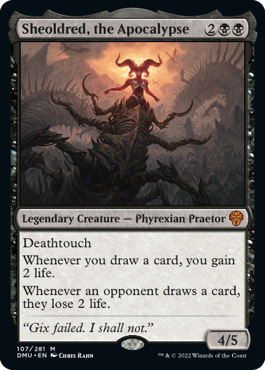

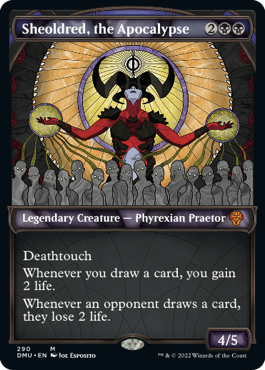
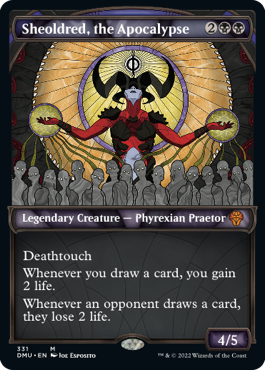
Sheoldred is a black Phyrexian Praetor who first showed up in New Phyrexia.
The Scars of Mirrodin block told the story of the Phyrexian invasion of Mirrodin resulting in a war that the Phyrexians won. They then remade Mirrodin into New Phyrexia. Once that happened, the Phyrexians started fighting amongst themselves, and each color got their own Praetor. Sheoldred was black's Praetor, and she was really into enslaving other creatures. Sheoldred's story that didn't come to be takes place in Throne of Eldraine. At least once upon a time it did.
You see, the previous set was War of the Spark, which finished up a three-year story arc about Nicol Bolas. The next big story we wanted to tell was about the Phyrexians, so we were figuring out how to start layering that story into the upcoming sets. The idea we really liked was that the first time we saw a Praetor, we wouldn't say anything about it. Nothing else in the set would focus on it. It would just be something for the Vorthoses to take note of and start worrying about. For those non-Vorthoses reading this, when last we left the Phyrexians, they were trapped on New Phyrexia with no way to planeswalk. This meant seeing a known Phyrexian (i.e., one we knew was on New Phyrexia) on another plane was a big warning sign that something had gone terribly wrong.
Our pick for the first Praetor to make an appearance wasn't Vorinclex, who ended up fulfilling this role in Kaldheim, but Sheoldred. Here was the plan: Throne of Eldraine was originally going to be two sets (codenamed "Archery" and "Baseball") rather than one. The first set was going to introduce the world and show off the courts. We'd meet twins Rowan and Will (who we first met in Battlebond) and learn that their father, the king, was missing. The second set would involve Rowan and Will traveling into the forest to find their father only to come face to face with his kidnapper. No, not Oko. He didn't exist as a character yet. The original villain was going to be someone we just referred to as the Whispering Witch. You were going to hear about her in "Archery," but she wouldn't get her own card until "Baseball." The card would just say Whispering Witch, but her image would be that of Sheoldred. We knew that would be enough to make the Vorthoses sit up and take notice.
But then a lot of things changed. We decided to make Eldraine just one set. We got a lot of feedback that the players want to take a bit of a breather from the overarching storyline. The Creative team got some other interesting ideas about how the story could work. Anyway, when the dust settled, Sheoldred was removed from the Throne of Eldraine story. Vorinclex would go on to be the first warning sign, and Sheoldred got moved to later in the story, to the part where we returned to Dominaria, which brings us to her design in Dominaria United.
Sheoldred, Whisperer-Listener (version #1)
4BB
Legendary Creature — Phyrexian Praetor
6/6
Menace, deathtouch
At the beginning of your precombat main phase, each opponent discards a card.
You may play a card from each opponent's graveyard on each of your turns.
You may spend mana as if it were any type to do this.
The Praetors in New Phyrexia were designed as a cycle. Each of them had two abilities (and most had an evergreen keyword ability), one that helped you, and one that hurt the opponent. These two abilities were reflections of one another. When we first started designing the new Praetors, there was a lot of discussion of whether we had to follow the same design structure. This first version was exploring space if the card didn't follow the previous Praetor design, although it still had a sense of violation, of messing with your opponent.
Sheoldred, Whisperer-Listener (version #2)
3BB
Legendary Creature — Phyrexian Praetor
4/6
Menace, deathtouch
Whenever an opponent draws cards, they exile that many cards from the top of their library. You may play those cards for as long as they remain exiled, and you may spend mana as though it were mana of any color to cast those spells.
This version still allows you to cast your opponent's spells but lessens the amount of card disadvantage. The opponent is losing cards off the top of their library instead of cards from their hand. Also, this version only lets you cast cards that were exiled by Sheoldred.
Sheoldred, Whisperer-Listener (version #3)
3BB
Legendary Creature — Phyrexian Praetor
4/4
Menace
Whenever CARDNAME or another creature you control dies, each opponent loses life equal to that creature's power.
Whenever a creature an opponent controls dies, you gain life equal to its power.
Sheoldred was the fourth Praetor to return in the current storyline (Vorinclex showed up in Kaldheim, Jin-Gitaxias showed up in Kamigawa: Neon Dynasty, and Urabrask showed up in Streets of New Capenna). Each of the previous three followed the same design template of the original Praetor cycle, so the design team realized they had to do the same. Here's the first attempt to do that. My creatures die, you lose life equal to their power. Your creatures die, I gain life equal to their power. Deathtouch would also go away, never to return.
Sheoldred, Whisperer-Listener (version #4)
5BB
Legendary Creature — Phyrexian Praetor
7/7
Menace
Whenever an opponent casts a creature spell, they lose life equal to its mana value.
During each of your turns, you may cast a creature spell by paying life equal to its mana value instead of paying its mana cost.
This next design was a little looser in its reflection. Both involved creature and life loss/payment, but it didn't line up quite as neatly.
Sheoldred, Whisperer-Listener (version #5)
2BB
Legendary Creature — Phyrexian Praetor
4/4
Menace
Whenever you cast a spell, you gain 1 life for each black mana symbol in that spell's mana cost.
Whenever an opponent casts a spell, they lose 1 life for each color of mana in that spell's mana cost.
This version tightens up the reflection a bit, although one effect cares about black mana specifically, while the other cares about any color mana symbol. In the end, the design does what a few of the Praetor designs have done in the past, which is make one effect that is in color and another effect that is a reflection but a little bit of a bend. The opponent losing life when they draw a card is quite black. You gaining life off of a positive effect you generated is less so. Again, more bend than break, and it played well, so this is the design Sheoldred ended up with.
Finally, here is her art description:
Setting: Dominaria
Color: Legendary creature associated with black mana
Location: On one of the volcanic plains of Shiv. Ash and sulfur swirling in the air.
Action: This is the epic movie poster shot of SHEOLDRED, the terrifying leader of the Phyrexians on Dominaria. Her human upper body (see 293) is affixed now to the top of a DRAGON ENGINE (see 288) with many legs, or multiple dragon engines affixed together like a centipede; headless, it drags her forward. In the sulfurous smoke, inhuman silhouettes throng behind her; she's at the head of an awful Phyrexian army.
Focus: SHEOLDRED
Mood: A monstrous villain at the height of her power
What Might Have Been
I hope you enjoyed my peering into stories that didn't come to be. As always, I'm eager to hear any feedback on my column, on any of the cards I talked about, or on Dominaria United itself. You can email me or contact me through any of my social media accounts (Twitter, Tumblr, Instagram, and TikTok).
Join me next week for more card-by-card design stories from Dominaria United.
Until then, may you dream of stories that never happened.
#961: Barry Reich
#961: Barry Reich
32:00
In this podcast, I interview Barry Reich, Magic's very first playtester.
#962: My Wizards Origin Story
#962: My Wizards Origin Story
33:31
I've briefly told listeners how I came to work for Wizards, but this podcast goes a bit more in depth into how it happened.
- Episode 960 Enchantment Types
- Episode 959 Playtest Cards
- Episode 958 Snow

